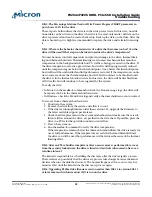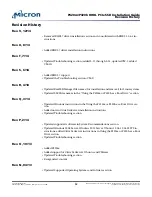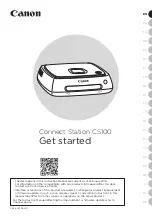
DB-3: The Percentage Lifetime Used or Write Protect Progress SMART parameter re-
port shows 100% for the drive
These reports both indicate the drive is in the write protect state. In this state, no addi-
tional data can be written to the drive (the drive is in a read-only mode). All data on the
drive is preserved and can be read or backed up. Back up the data on the drive. After the
data is backed up, it is highly recommended to replace the drive and refrain from using
it.
DB-4: What are the behavior characteristics of a drive that becomes too hot? Can the
drive still be used? What steps can be taken to reduce the drive's temperature?
Two mechanisms control temperature and prevent damage to the drive: thermal limit-
ing and thermal shutdown. Thermal limiting is a dynamic mechanism that monitors
temperature in the background while host I/O traffic is being processed on the drive. If
the drive temperature exceeds a preset limit, host traffic will be progressively reduced
until the temperature goes below the threshold point. Once below this threshold point,
host traffic will be unthrottled and full performance restored. If the temperature contin-
ues to increase above the threshold point, host IOPS will continue to be throttled until
the drive is in the thermal shutdown state. In this state, the drive will be disabled from
all I/O traffic but will continue to be recognized by the system.
To verify the state:
• In Linux: run the
rssdm –L
command or check the Linux message logs (the drive will
be reported to be in the thermal shutdown state).
• In Windows: check the Event/Error log and verify a thermal shutdown event occurred.
To recover from a thermal shutdown state:
1. Shut down the system.
2. Remove the drive from the system and allow it to cool.
3. If the drive is running firmware older than version 1.45, upgrade the firmware to
the latest available support pack release.
4. Check the drive placement in the system motherboard and make sure there is suf-
ficient airflow around the drive, as specified in the data sheet. If possible, place the
drive in a PCIe slot that provides unobstructed airflow.
5. Power the system on.
6. Run the
rssdm –L
command to verify the drive temperature.
If the temperature remains below the thermal threshold limit, the drive is ready for
use at full performance. If the temperature exceeds the thermal threshold limit,
the drive can still be used but performance will be reduced because of the thermal
limiting effect.
DB-5: After an FTL rebuild is complete or after a secure erase is performed to recover
from the security locked state, the drive is listed in /dev/disks (discovered) after a cer-
tain time interval
The kernel is responsible for scheduling the discovery after the driver signals a rescan.
There is always a possibility that the discovery process takes longer because the kernel
decides when to schedule the discovery. The normal frequency of re-scan is every five
minutes. Wait until the kernel runs the discovery process again.
DB-6: Upgrading P420m drive firmware version earlier than 208.11 to version 208.11
or later may result in future errors if IO is run on the drive
P420m/P320h HHHL PCIe SSD Installation Guide
Troubleshooting
PDF: 09005aef8497e00a
P420m_P320h_HHHL_installation_guide.pdf - Rev. V 12/14 EN
48
Micron Technology, Inc. reserves the right to change products or specifications without notice.
©
2012 Micron Technology, Inc. All rights reserved.








































